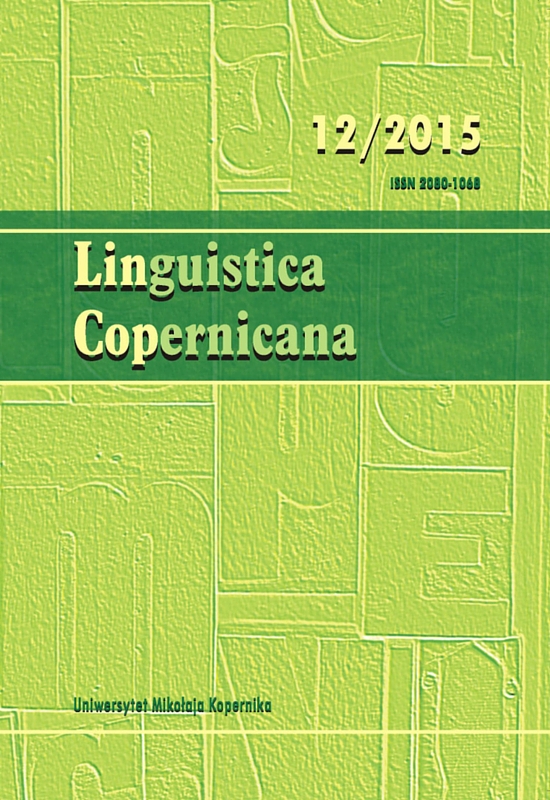Sind Aphorismen hypertextuell? Zur konzeptionellen Hypertextualität analoger Texte
DOI:
https://doi.org/10.12775/LinCop.2015.012Słowa kluczowe
Text, Kohärenz, Aphorismus, Hypertext, HypertextualitätAbstrakt
Im folgenden Beitrag wird ein Versuch unternommen, konzeptionelle Ähnlichkeiten zwischen zwei medial unterschiedlichen Textformen – dem Aphorismus und dem Hypertext – aufzuzeigen. Um das anvisierte Ziel realisieren zu können, wird auf das Kriterium der Kohärenz zurückgegriffen. Dabei wird für einen umfassenderen, prozessbezogenen Kohärenz-Begriff plädiert, der den Leser selbst als Kohärenzstifter miteinschließt. Im Mittelpunkt der Analyse steht der Aphorismus mit seiner fragmentarischen Struktur, die zum Mitkonstituieren des Textsinns auffordert. An einigen Aphorismen von K. Kraus, E. Canetti und S. J. Lec wird versucht, konzeptionelle Hypertextualität dieser Texte zu explizieren.
Bibliografia
BARTHES R., 1973/1986, Die Lust am Text, Frankfurt a. M.: Suhrkamp.
BERRESSEM H., 2000, Unterwegs im Docuversum. Zur Topologie des Hypertext, In: M. Klepper, R. Mayer, E.-P. Schneck (Hrsg.), Hyperkultur. Zur Fiktion des Computerzeitalters, Berlin, New York: de Gruyter, S. 108–129.
CANETTI E., 1990, Das Geheimherz der Uhr. Aufzeichnungen 1973–1985, Frankfurt a. M.: Fischer.
ENGELMANN S., 1997, Babel – Bibel – Bibliothek. Canettis Aphorismen zur Sprache. Würzburg: Königshausen & Neumann.
FEDLER S., 1992, Der Aphorismus. Begriffsspiel zwischen Philosophie und Poesie, Stuttgart: Metzler.
FRICKE H., 1984, Aphorismus, Stuttgart: Metzler.
FRIES N., 2006, ›The bigger, the better‹. Zur Sprach- und Kulturspezifik von Texten, In: F. Grucza (Hrsg.), Texte – Gegenstände germanistischer Forschung und Lehre, Warszawa: Euro-Edukacja, S. 129–142.
GANSEL CH., JÜRGENS F., 2007, Textlinguistik und Textgrammatik, Göttingen: Vandenhoeck & Ruprecht.
GRAFF S., 1973, Vom Baum der Erkenntnis. Aphorismen, Krefeld: Scherpe.
HENDRICH A., 2003, Spurenlesen – Hyperlinks als kohärenzbildendes Element in Hypertext, München [on-line], http://edoc.ub.uni-muenchen.de/3054/1/Hendrich_Andreas.pdf, [04.07.2014].
HESS-LÜTTICH E. W. B., 2006, Textbegriffe der Sprach-, Literatur- und Medienwissenschaften im Zeichen technischer Umbrüche, In: F. Grucza (Hrsg.), Texte – Gegenstände germanistischer Forschung und Lehre, Warszawa: Eu-ro-Edukacja, S. 177–191.
HOLZ H. H., 1990, Dialektik, In: H. J. Sandkühler (Hrsg.), Europäische Enzyklopädie zu Philosophie und Wissenschaften, Hamburg: Meiner, S. 547–568.
IDENSEN H., 1995, Hypertext als Utopie. Entwürfe postmoderner Schreibweisen und Kulturtechniken, [on-line], http://www.netzliteratur.net/idensen/utopie.html, [14.07.2014].
ISKE S., 2001, Hypertext als Technologie des Umgangs mit Information, Spektrum Freizeit 23/1, S. 91–110.
JAKOBS E.-M., 2011, Hypertextuelle Kommunikate, In: S. M. Moraldo (Hrsg.), Inter-net.kom. Neue Sprach- und Kommunikationsformen im WorldWideWeb, Band 2: Medialität, Hypertext, digitale Literatur, Rom: Arcane, S. 57–79.
JAKOBS E.-M., LEHNEN K., 2005, Hypertext – Klassifikation und Evaluation, In: T. Sieber, P. Schlobinski, J. Runkehl (Hrsg.), Websprache.net. Sprache und Kommunikation im Internet, Berlin, New York: de Gruyter, S. 159–184.
KRAUS K., 1986, Schriften. Bd. 8: Aphorismen. Sprüche und Widersprüche. Pro domo et mundo. Nachts, Frankfurt a. M.: Suhrkamp.
LEC S. J., 1996, Sämtliche unfrisierte Gedanken. Dazu Prosa und Gedichte. Hrsg. und aus dem Polnischen übertragen von K. Dedecius, München,Wien: Carl Hanser.
LUBIMOVA-BEKMAN L., 2001, Rezeption von Aphorismen. Eine textlinguistische Studie, Berlin: Erich Schmidt.
PFEIFFER P. C., 1990, Aphorismus und Romanstruktur. Zu Robert Musils „Der Mann ohne Eigenschaften”, Berlin: Bouvier.
REITBAUER, M. (2007): Die Textstruktur als Navigationssystem: Lesepfade und ihre Auswirkung auf das Verstehen von Informationen im Medium Hypertext. In: LSP & Professional Communication, 7/2, 49–72.
ROTHKEGEL A., 2001, Stil und/oder Design, In: E.-M. Jakobs, A. Rothkegel (Hrsg.), Perspektiven auf Stil, Tübingen: Niemeyer, S. 77–88.
SCHWEIGER W., 2001, Hypermedien im Internet. Nutzung und ausgewählte Effekte der Linkgestaltung, München: Reinhard Fischer.
STORRER A., 2004, Kohärenz in Hypertexten, Zeitschrift für germanistische Linguistik 31/2, S. 274–292.
STORRER A., 2008, Hypertextlinguistik, In: N. Janich (Hrsg.), Textlinguistik. 15 Einführungen, Tübingen: Narr, S. 315–331.
STORRER A., 2013, Sprachstil und Sprachvariation in sozialen Netzwerken, In: B. Frank-Job, A. Mehler, T. Sutter (Hrsg.), Die Dynamik sozialer uns sprachlicher Netzwerke. Konzepte, Methoden und empirische Untersuchungen an Beispielen des WWW, Wiesbaden: Springer VS, S. 331–366.
STÖLZEL T., 1998, Rohe und polierte Gedanken. Studien zur Wirkungsweise aphoristischer Texte, Freiburg im Breisgau: Rombach.
SUTER B., 2000, Hyperfiktion und interaktive Narration im frühen Entwicklungsstadium zu einem Genre, Zürich: update.
SZCZEPANIAK J., 2002, Zu sprachlichen Realisierungsmitteln der Komik in ausgewählten aphoristischen Texten aus pragmalinguistischer Sicht, Frankfurt a. M.: Lang.
WAWRZYNIAK Z., 1996, Lakonik – Linguistik der Kürze und Bündigkeit, Zeszyty Na-ukowe WSP w Rzeszowie. Językoznawstwo 3, s. 215–221.
WAWRZYNIAK Z., 2006, Textbildungsprinzipien, In: F. Grucza (Hg.), Texte – Gegen-stände germanistischer Forschung und Lehre, Warszawa: Euro-Edukacja, S. 31–40.
WIRTH U., 2004, Hypertextualität als Gegenstand einer intermedialen Literaturwissenschaft, In: W. Erhart (Hrsg.), Grenzen der Germanistik. Stuttgart, Weimar: Metzler, S. 410–430.
WIRTH U., 2005, Die epistemologische Rolle von Links in Wissensprozessen. Eine mediengeschichtliche Rekonstruktion, In: P. Gendolla, J. Schäfer (Hrsg.), Wissensprozesse in der Netzwerkgesellschaft, Bielefeld: transcript, S. 43–54.
WIRTH U., 2005a, Hypertext, In: A. Roesler, B. Stiegler (Hrsg.): Grundbegriffe der Medientheorie, München: Fink, S. 86–94.
WITTGENSTEIN L., 1953/2003, Philosophische Untersuchungen, Frankfurt a. M.: Suhrkamp.
ŻEBROWSKA E., 2013 Text – Bild – Hypertext, Frankfurt a. M.: Lang.
Pobrania
Opublikowane
Jak cytować
Numer
Dział
Statystyki
Liczba wyświetleń i pobrań: 595
Liczba cytowań: 0



